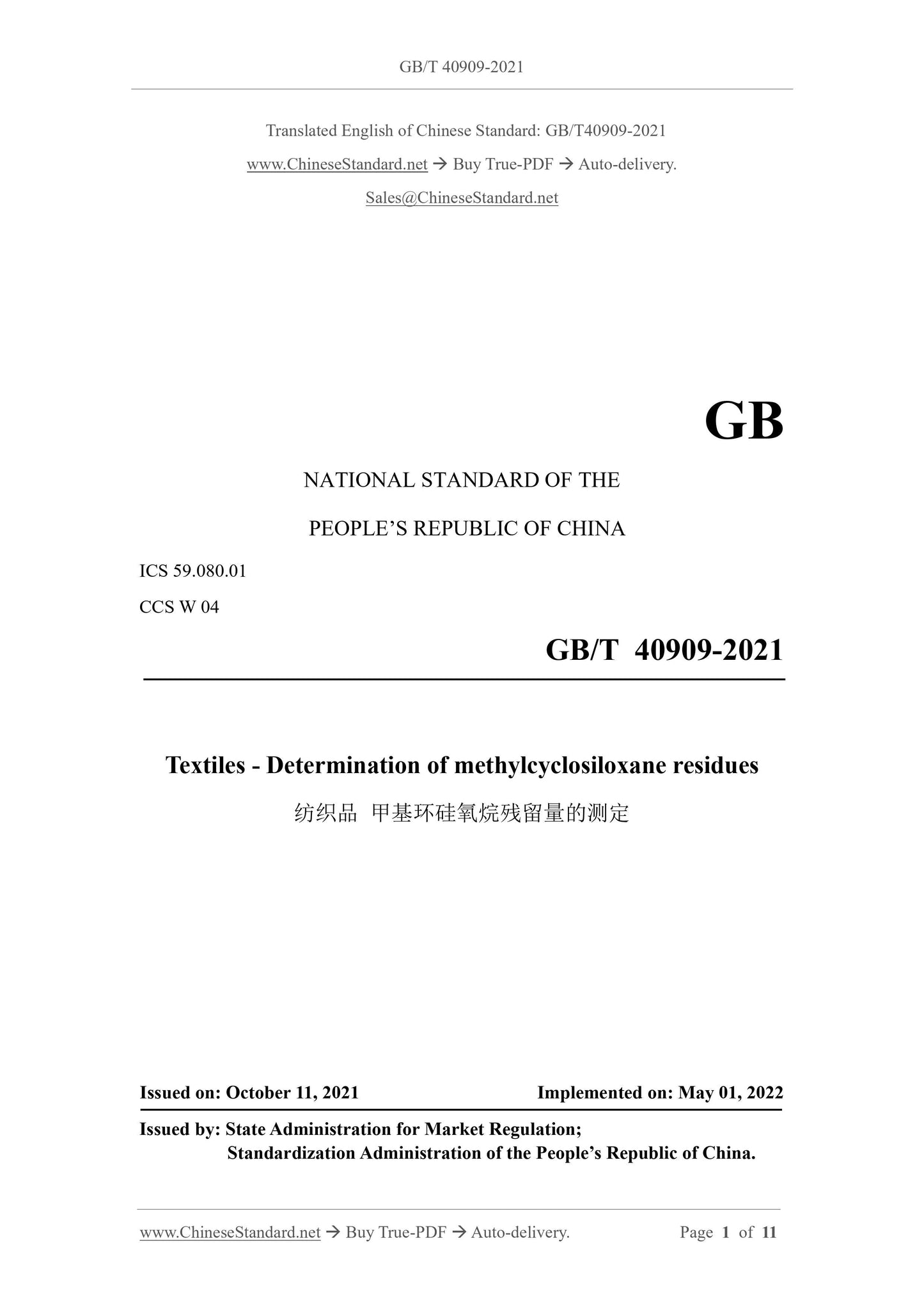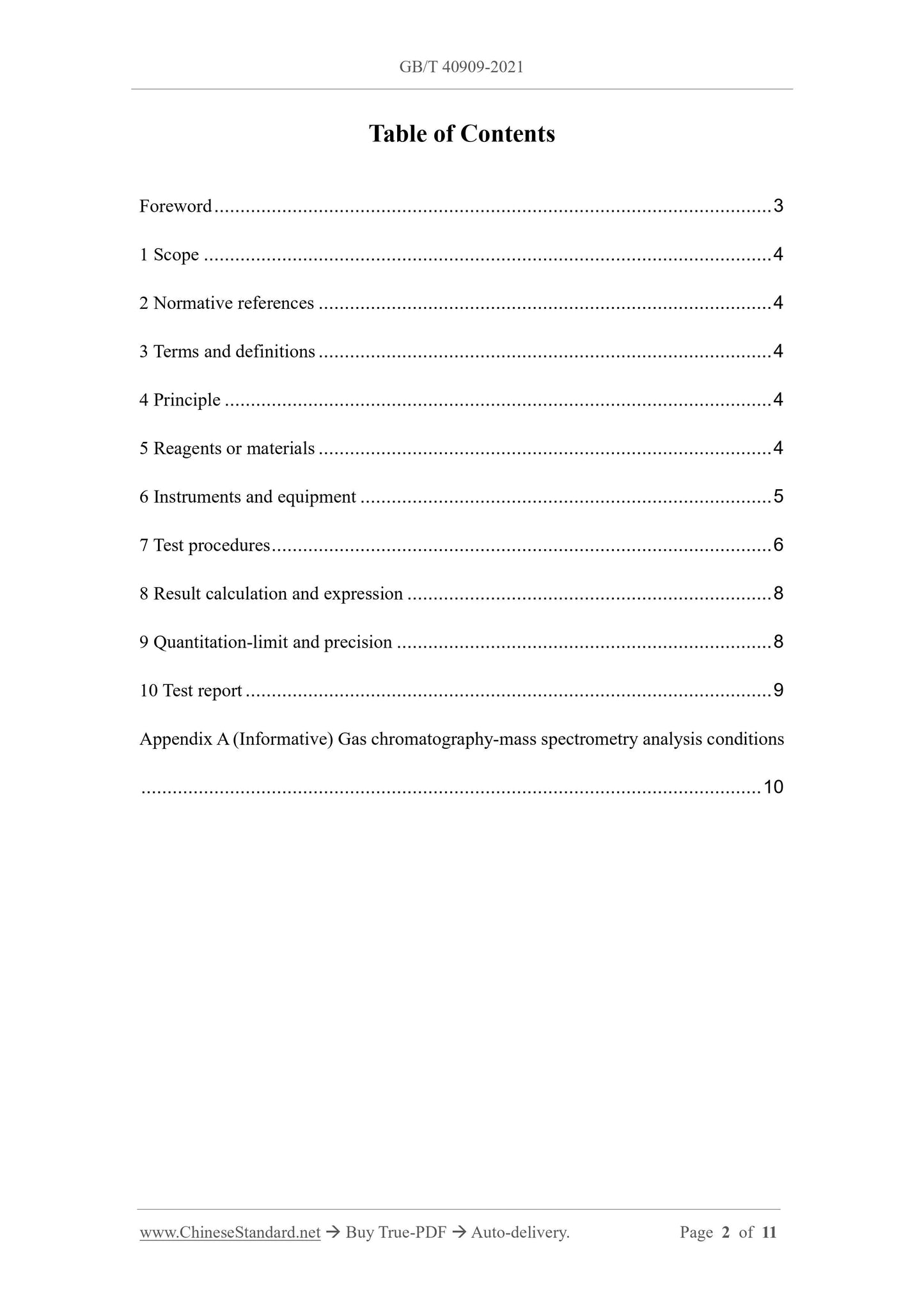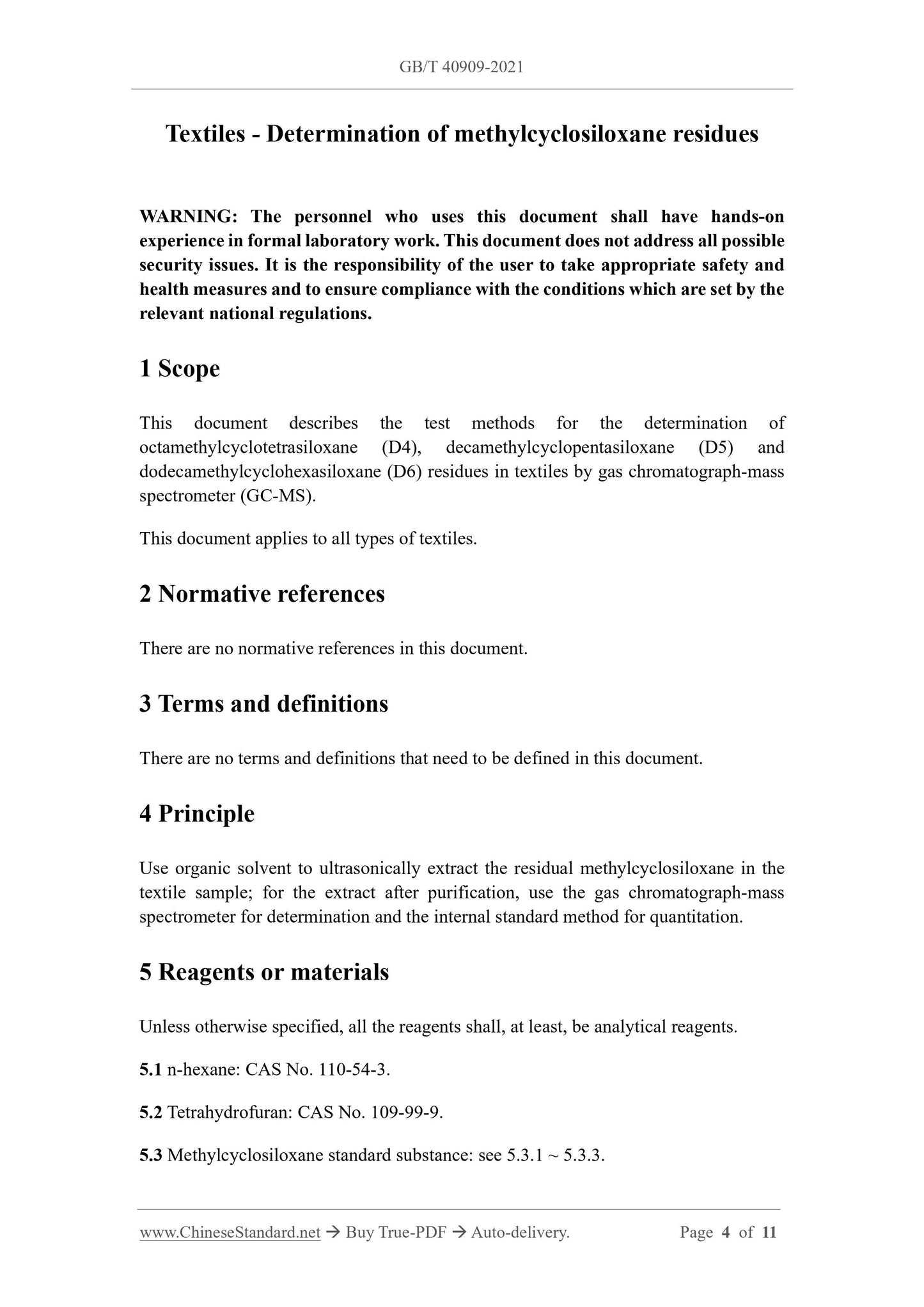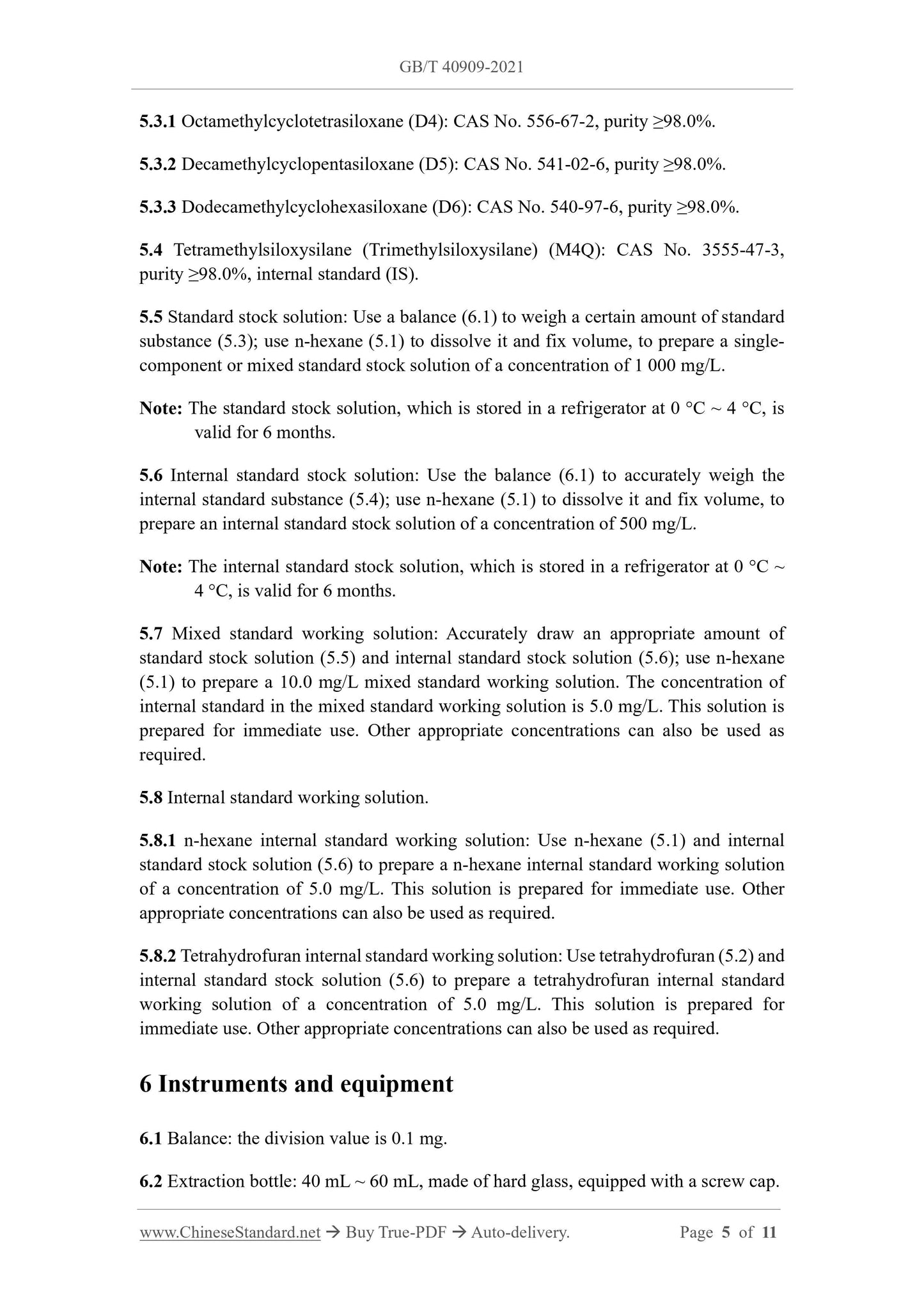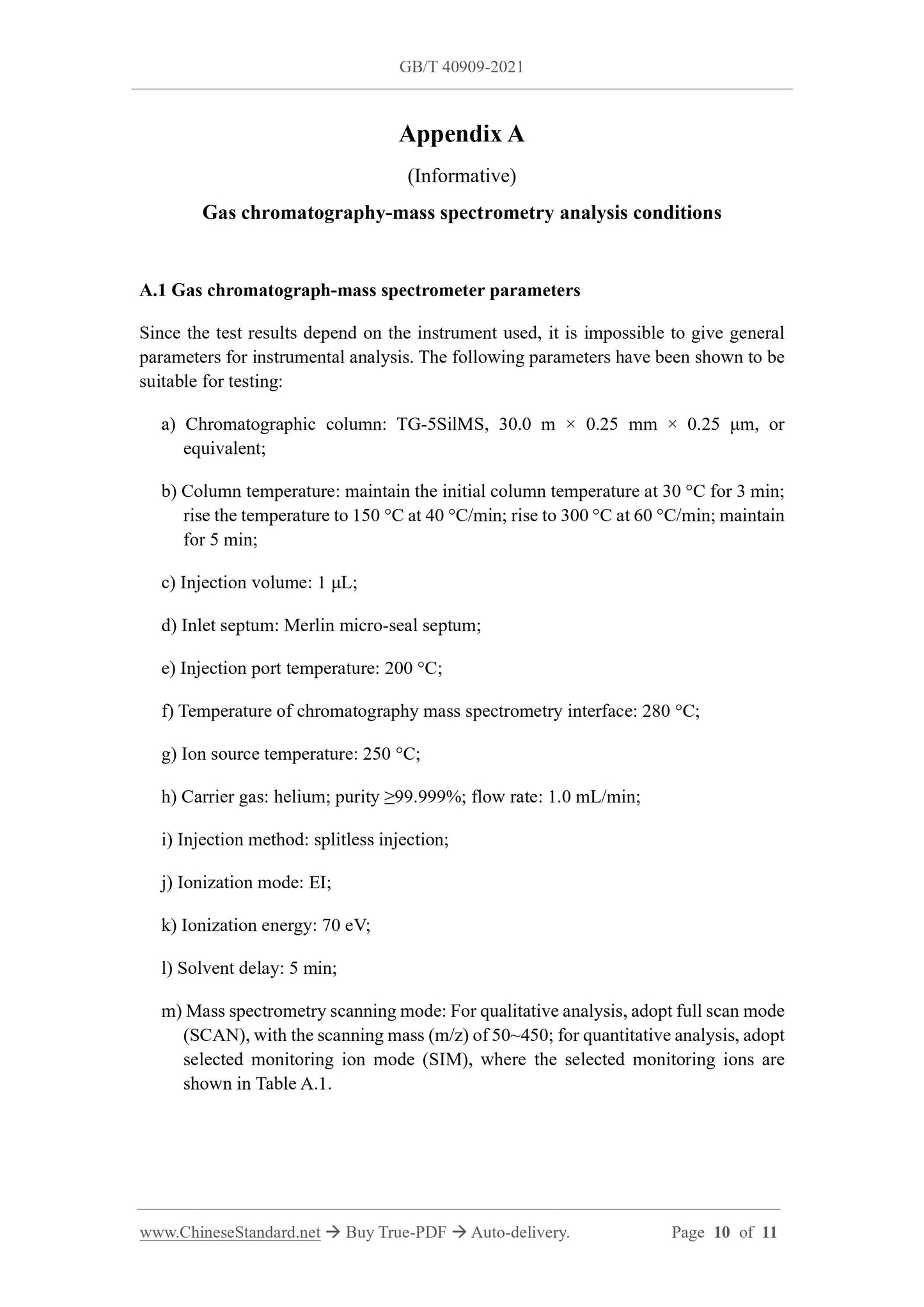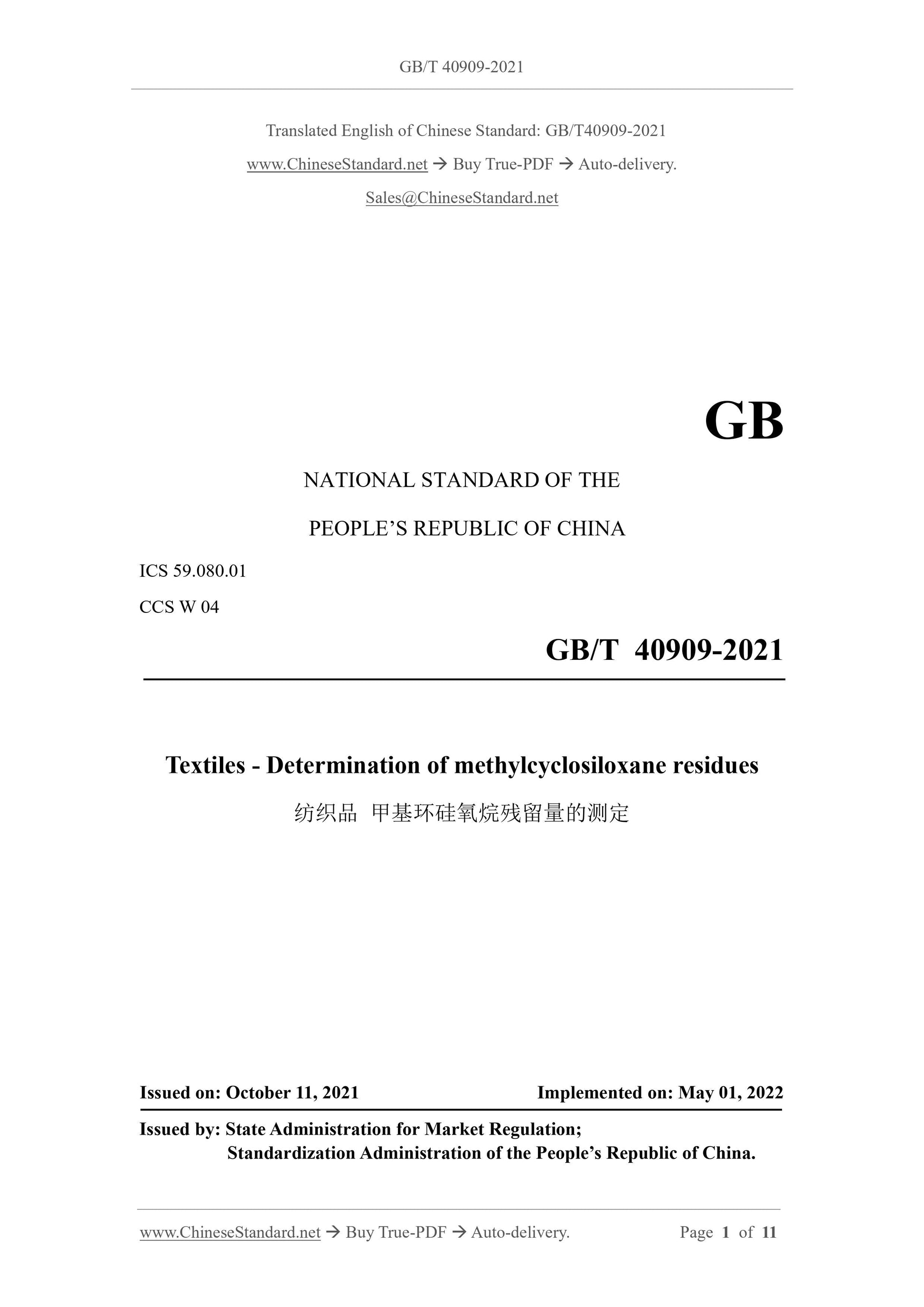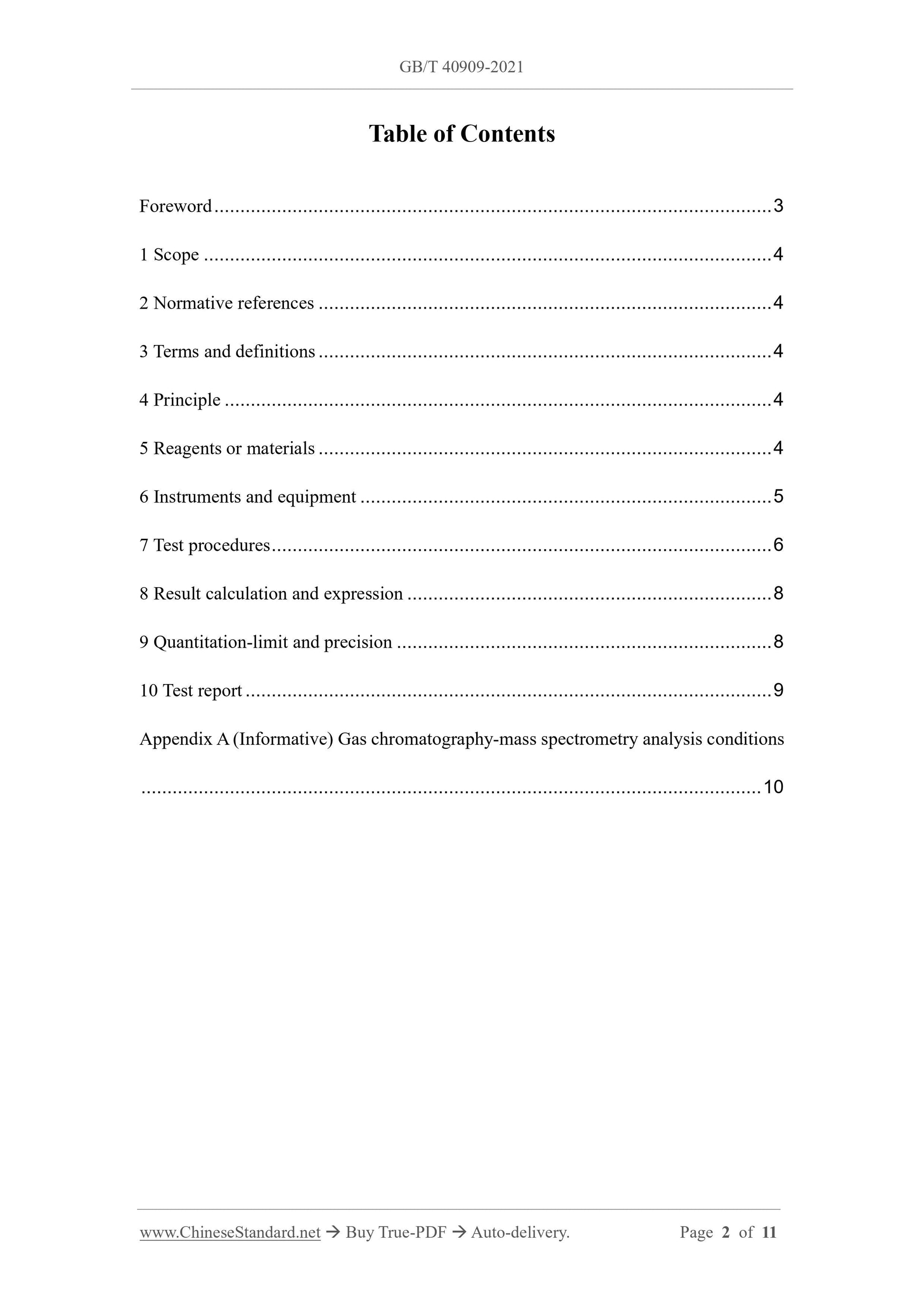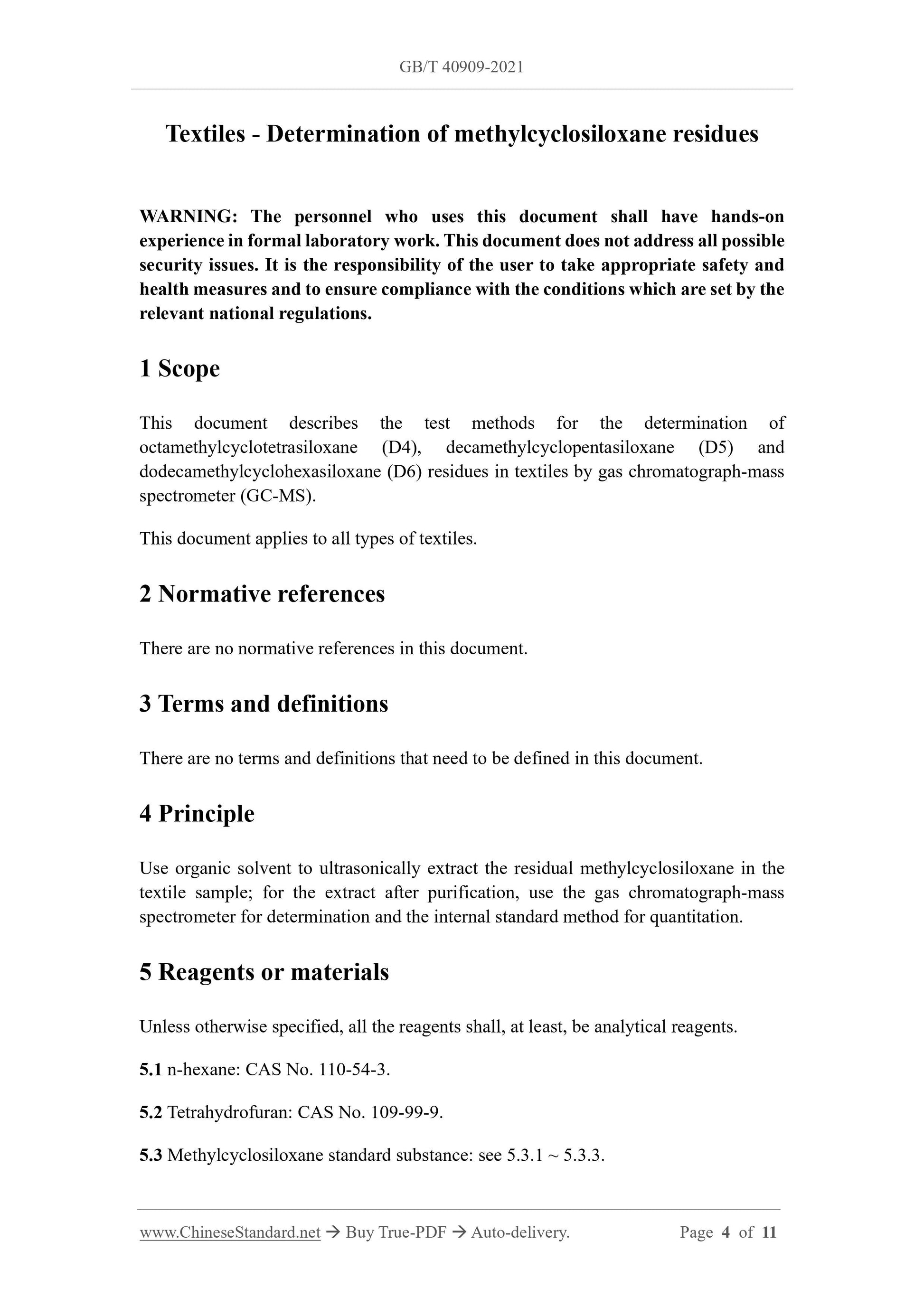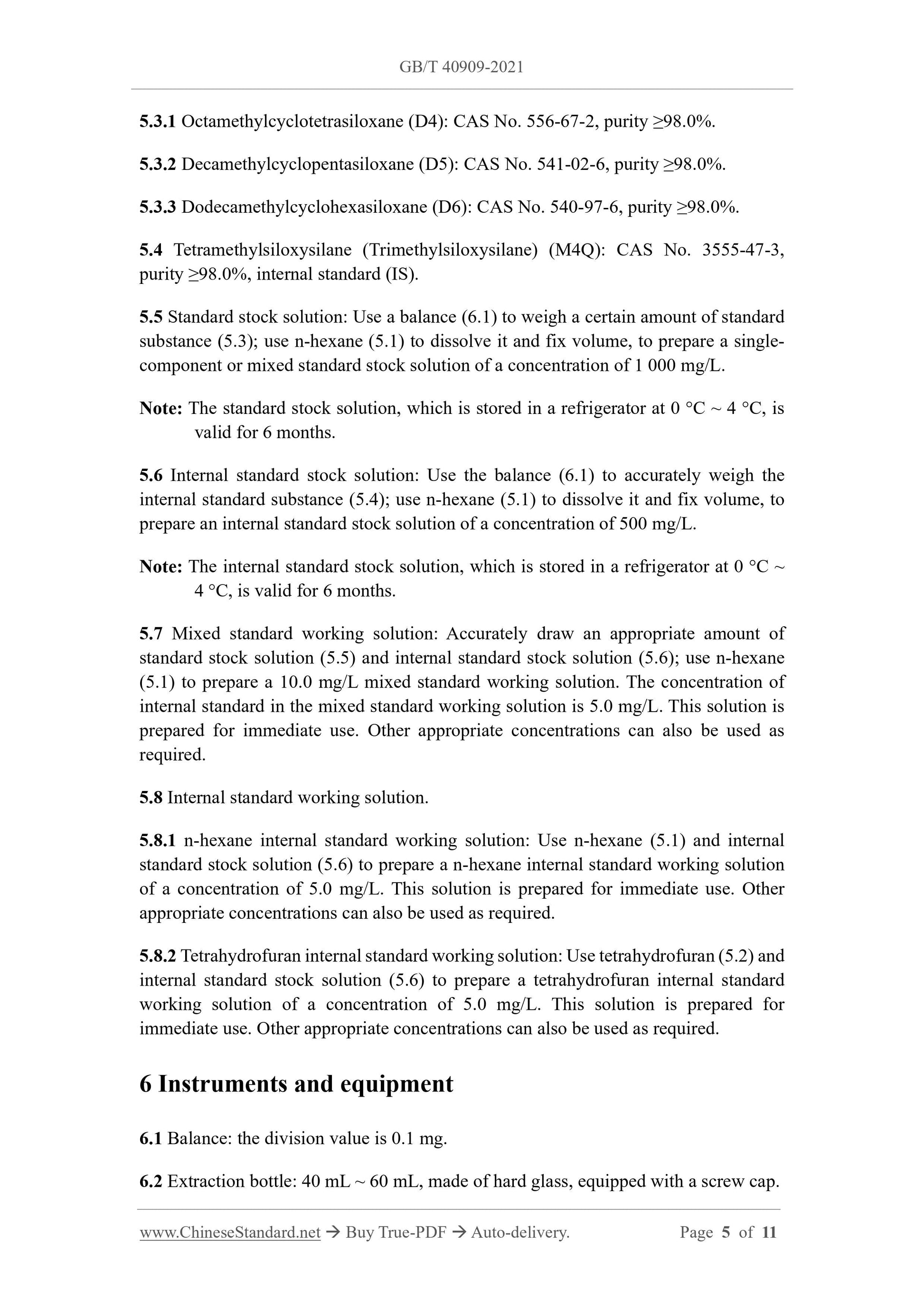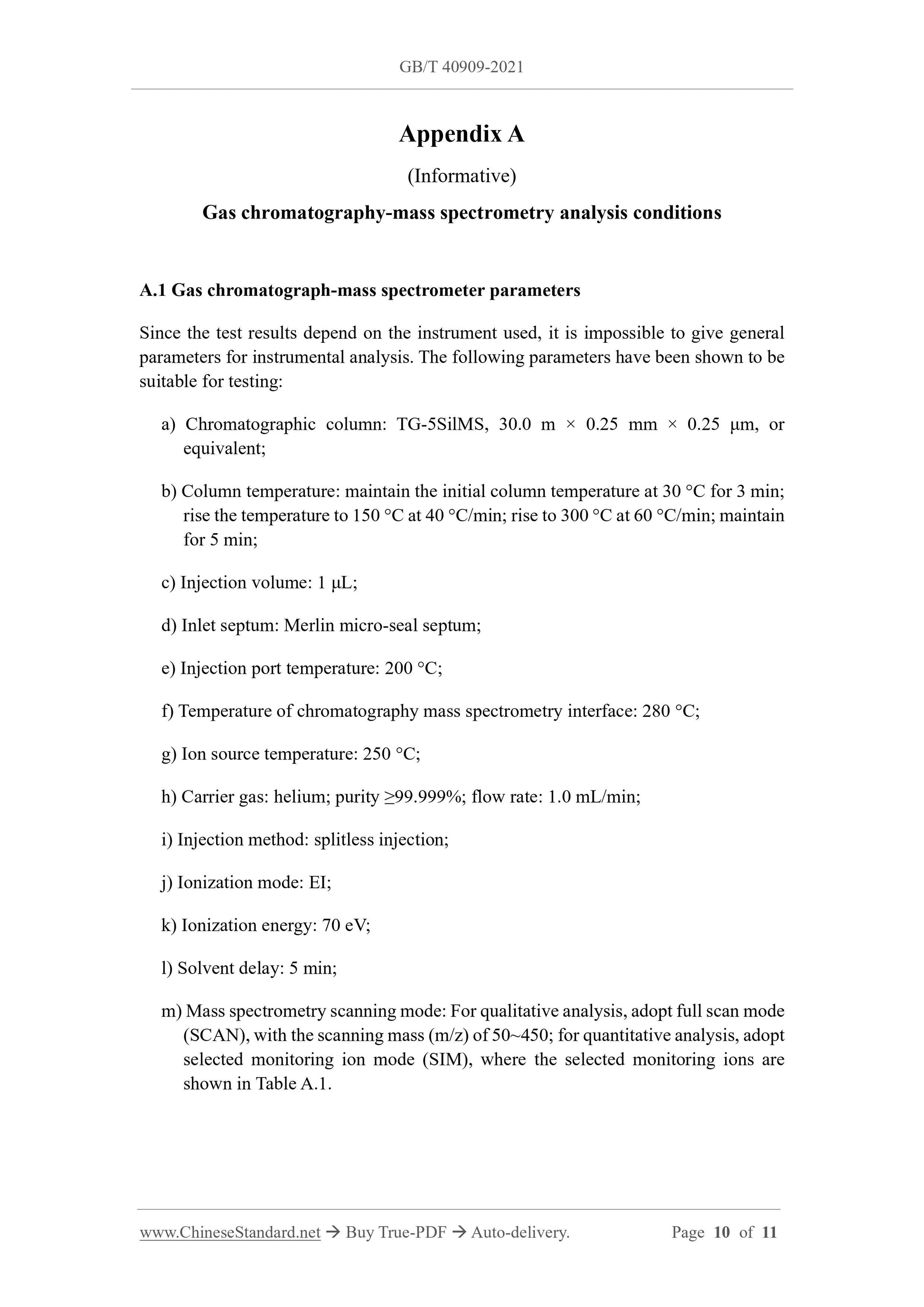1
/
of
5
www.ChineseStandard.us -- Field Test Asia Pte. Ltd.
GB/T 40909-2021 English PDF (GB/T40909-2021)
GB/T 40909-2021 English PDF (GB/T40909-2021)
Regular price
$185.00
Regular price
Sale price
$185.00
Unit price
/
per
Shipping calculated at checkout.
Couldn't load pickup availability
GB/T 40909-2021: Textiles - Determination of methylcyclosiloxane residues
Delivery: 9 seconds. Download (& Email) true-PDF + Invoice.
Get Quotation: Click GB/T 40909-2021 (Self-service in 1-minute)
Historical versions (Master-website): GB/T 40909-2021
Preview True-PDF (Reload/Scroll-down if blank)
GB/T 40909-2021
GB
NATIONAL STANDARD OF THE
PEOPLE’S REPUBLIC OF CHINA
ICS 59.080.01
CCS W 04
Textiles - Determination of methylcyclosiloxane residues
ISSUED ON: OCTOBER 11, 2021
IMPLEMENTED ON: MAY 01, 2022
Issued by: State Administration for Market Regulation;
Standardization Administration of the People’s Republic of China.
Table of Contents
Foreword ... 3
1 Scope ... 4
2 Normative references ... 4
3 Terms and definitions ... 4
4 Principle ... 4
5 Reagents or materials ... 4
6 Instruments and equipment ... 5
7 Test procedures ... 6
8 Result calculation and expression ... 8
9 Quantitation-limit and precision ... 8
10 Test report ... 9
Appendix A (Informative) Gas chromatography-mass spectrometry analysis conditions
... 10
Textiles - Determination of methylcyclosiloxane residues
WARNING: The personnel who uses this document shall have hands-on
experience in formal laboratory work. This document does not address all possible
security issues. It is the responsibility of the user to take appropriate safety and
health measures and to ensure compliance with the conditions which are set by the
relevant national regulations.
1 Scope
This document describes the test methods for the determination of
octamethylcyclotetrasiloxane (D4), decamethylcyclopentasiloxane (D5) and
dodecamethylcyclohexasiloxane (D6) residues in textiles by gas chromatograph-mass
spectrometer (GC-MS).
This document applies to all types of textiles.
2 Normative references
There are no normative references in this document.
3 Terms and definitions
There are no terms and definitions that need to be defined in this document.
4 Principle
Use organic solvent to ultrasonically extract the residual methylcyclosiloxane in the
textile sample; for the extract after purification, use the gas chromatograph-mass
spectrometer for determination and the internal standard method for quantitation.
5 Reagents or materials
Unless otherwise specified, all the reagents shall, at least, be analytical reagents.
5.1 n-hexane: CAS No. 110-54-3.
5.2 Tetrahydrofuran: CAS No. 109-99-9.
5.3 Methylcyclosiloxane standard substance: see 5.3.1 ~ 5.3.3.
5.3.1 Octamethylcyclotetrasiloxane (D4): CAS No. 556-67-2, purity ≥98.0%.
5.3.2 Decamethylcyclopentasiloxane (D5): CAS No. 541-02-6, purity ≥98.0%.
5.3.3 Dodecamethylcyclohexasiloxane (D6): CAS No. 540-97-6, purity ≥98.0%.
5.4 Tetramethylsiloxysilane (Trimethylsiloxysilane) (M4Q): CAS No. 3555-47-3,
purity ≥98.0%, internal standard (IS).
5.5 Standard stock solution: Use a balance (6.1) to weigh a certain amount of standard
substance (5.3); use n-hexane (5.1) to dissolve it and fix volume, to prepare a single-
component or mixed standard stock solution of a concentration of 1 000 mg/L.
Note: The standard stock solution, which is stored in a refrigerator at 0 °C ~ 4 °C, is
valid for 6 months.
5.6 Internal standard stock solution: Use the balance (6.1) to accurately weigh the
internal standard substance (5.4); use n-hexane (5.1) to dissolve it and fix volume, to
prepare an internal standard stock solution of a concentration of 500 mg/L.
Note: The internal standard stock solution, which is stored in a refrigerator at 0 °C ~
4 °C, is valid for 6 months.
5.7 Mixed standard working solution: Accurately draw an appropriate amount of
standard stock solution (5.5) and internal standard stock solution (5.6); use n-hexane
(5.1) to prepare a 10.0 mg/L mixed standard working solution. The concentration of
internal standard in the mixed standard working solution is 5.0 mg/L. This solution is
prepared for immediate use. Other appropriate concentrations can also be used as
required.
5.8 Internal standard working solution.
5.8.1 n-hexane internal standard working solution: Use n-hexane (5.1) and internal
standard stock solution (5.6) to prepare a n-hexane internal standard working solution
of a concentration of 5.0 mg/L. This solution is prepared for immediate use. Other
appropriate concentrations can also be used as required.
5.8.2 Tetrahydrofuran internal standard working solution: Use tetrahydrofuran (5.2) and
internal standard stock solution (5.6) to prepare a tetrahydrofuran internal standard
working solution of a concentration of 5.0 mg/L. This solution is prepared for
immediate use. Other appropriate concentrations can also be used as required.
6 Instruments and equipment
6.1 Balance: the division value is 0.1 mg.
6.2 Extraction bottle: 40 mL ~ 60 mL, made of hard glass, equipped with a screw cap.
Appendix A
(Informative)
Gas chromatography-mass spectrometry analysis conditions
A.1 Gas chromatograph-mass spectrometer parameters
Since the test results depend on the instrument used, it is impossible to give general
parameters for instrumental analysis. The following parameters have been shown to be
suitable for testing:
a) Chromatographic column: TG-5SilMS, 30.0 m × 0.25 mm × 0.25 μm, or
equivalent;
b) Column temperature: maintain the initial column temperature at 30 °C for 3 min;
rise the temperature to 150 °C at 40 °C/min; rise to 300 °C at 60 °C/min; maintain
for 5 min;
c) Injection volume: 1 μL;
d) Inlet septum: Merlin micro-seal septum;
e) Injection port temperature: 200 °C;
f) Temperature of chromatography mass spectrometry interface: 280 °C;
g) Ion source temperature: 250 °C;
h) Carrier gas: helium; purity ≥99.999%; flow rate: 1.0 mL/min;
i) Injection method: splitless injection;
j) Ionization mode: EI;
k) Ionization energy: 70 eV;
l) Solvent delay: 5 min;
m) Mass spectrometry scanning mode: For qualitative analysis, adopt full scan mode
(SCAN), with the scanning mass (m/z) of 50~450; for quantitative analysis, adopt
selected monitoring ion mode (SIM), where the selected monitoring ions are
shown in Table A.1.
GB/T 40909-2021
GB
NATIONAL STANDARD OF THE
PEOPLE’S REPUBLIC OF CHINA
ICS 59.080.01
CCS W 04
Textiles - Determination of methylcyclosiloxane residues
ISSUED ON: OCTOBER 11, 2021
IMPLEMENTED ON: MAY 01, 2022
Issued by: State Administration for Market Regulation;
Standardization Administration of the People’s Republic of China.
Table of Contents
Foreword ... 3
1 Scope ... 4
2 Normative references ... 4
3 Terms and definitions ... 4
4 Principle ... 4
5 Reagents or materials ... 4
6 Instruments and equipment ... 5
7 Test procedures ... 6
8 Result calculation and expression ... 8
9 Quantitation-limit and precision ... 8
10 Test report ... 9
Appendix A (Informative) Gas chromatography-mass spectrometry analysis conditions
... 10
Textiles - Determination of methylcyclosiloxane residues
WARNING: The personnel who uses this document shall have hands-on
experience in formal laboratory work. This document does not address all possible
security issues. It is the responsibility of the user to take appropriate safety and
health measures and to ensure compliance with the conditions which are set by the
relevant national regulations.
1 Scope
This document describes the test methods for the determination of
octamethylcyclotetrasiloxane (D4), decamethylcyclopentasiloxane (D5) and
dodecamethylcyclohexasiloxane (D6) residues in textiles by gas chromatograph-mass
spectrometer (GC-MS).
This document applies to all types of textiles.
2 Normative references
There are no normative references in this document.
3 Terms and definitions
There are no terms and definitions that need to be defined in this document.
4 Principle
Use organic solvent to ultrasonically extract the residual methylcyclosiloxane in the
textile sample; for the extract after purification, use the gas chromatograph-mass
spectrometer for determination and the internal standard method for quantitation.
5 Reagents or materials
Unless otherwise specified, all the reagents shall, at least, be analytical reagents.
5.1 n-hexane: CAS No. 110-54-3.
5.2 Tetrahydrofuran: CAS No. 109-99-9.
5.3 Methylcyclosiloxane standard substance: see 5.3.1 ~ 5.3.3.
5.3.1 Octamethylcyclotetrasiloxane (D4): CAS No. 556-67-2, purity ≥98.0%.
5.3.2 Decamethylcyclopentasiloxane (D5): CAS No. 541-02-6, purity ≥98.0%.
5.3.3 Dodecamethylcyclohexasiloxane (D6): CAS No. 540-97-6, purity ≥98.0%.
5.4 Tetramethylsiloxysilane (Trimethylsiloxysilane) (M4Q): CAS No. 3555-47-3,
purity ≥98.0%, internal standard (IS).
5.5 Standard stock solution: Use a balance (6.1) to weigh a certain amount of standard
substance (5.3); use n-hexane (5.1) to dissolve it and fix volume, to prepare a single-
component or mixed standard stock solution of a concentration of 1 000 mg/L.
Note: The standard stock solution, which is stored in a refrigerator at 0 °C ~ 4 °C, is
valid for 6 months.
5.6 Internal standard stock solution: Use the balance (6.1) to accurately weigh the
internal standard substance (5.4); use n-hexane (5.1) to dissolve it and fix volume, to
prepare an internal standard stock solution of a concentration of 500 mg/L.
Note: The internal standard stock solution, which is stored in a refrigerator at 0 °C ~
4 °C, is valid for 6 months.
5.7 Mixed standard working solution: Accurately draw an appropriate amount of
standard stock solution (5.5) and internal standard stock solution (5.6); use n-hexane
(5.1) to prepare a 10.0 mg/L mixed standard working solution. The concentration of
internal standard in the mixed standard working solution is 5.0 mg/L. This solution is
prepared for immediate use. Other appropriate concentrations can also be used as
required.
5.8 Internal standard working solution.
5.8.1 n-hexane internal standard working solution: Use n-hexane (5.1) and internal
standard stock solution (5.6) to prepare a n-hexane internal standard working solution
of a concentration of 5.0 mg/L. This solution is prepared for immediate use. Other
appropriate concentrations can also be used as required.
5.8.2 Tetrahydrofuran internal standard working solution: Use tetrahydrofuran (5.2) and
internal standard stock solution (5.6) to prepare a tetrahydrofuran internal standard
working solution of a concentration of 5.0 mg/L. This solution is prepared for
immediate use. Other appropriate concentrations can also be used as required.
6 Instruments and equipment
6.1 Balance: the division value is 0.1 mg.
6.2 Extraction bottle: 40 mL ~ 60 mL, made of hard glass, equipped with a screw cap.
Appendix A
(Informative)
Gas chromatography-mass spectrometry analysis conditions
A.1 Gas chromatograph-mass spectrometer parameters
Since the test results depend on the instrument used, it is impossible to give general
parameters for instrumental analysis. The following parameters have been shown to be
suitable for testing:
a) Chromatographic column: TG-5SilMS, 30.0 m × 0.25 mm × 0.25 μm, or
equivalent;
b) Column temperature: maintain the initial column temperature at 30 °C for 3 min;
rise the temperature to 150 °C at 40 °C/min; rise to 300 °C at 60 °C/min; maintain
for 5 min;
c) Injection volume: 1 μL;
d) Inlet septum: Merlin micro-seal septum;
e) Injection port temperature: 200 °C;
f) Temperature of chromatography mass spectrometry interface: 280 °C;
g) Ion source temperature: 250 °C;
h) Carrier gas: helium; purity ≥99.999%; flow rate: 1.0 mL/min;
i) Injection method: splitless injection;
j) Ionization mode: EI;
k) Ionization energy: 70 eV;
l) Solvent delay: 5 min;
m) Mass spectrometry scanning mode: For qualitative analysis, adopt full scan mode
(SCAN), with the scanning mass (m/z) of 50~450; for quantitative analysis, adopt
selected monitoring ion mode (SIM), where the selected monitoring ions are
shown in Table A.1.
Delivery: 9 seconds. Download (& Email) true-PDF + Invoice.
Get Quotation: Click GB/T 40909-2021 (Self-service in 1-minute)
Historical versions (Master-website): GB/T 40909-2021
Preview True-PDF (Reload/Scroll-down if blank)
GB/T 40909-2021
GB
NATIONAL STANDARD OF THE
PEOPLE’S REPUBLIC OF CHINA
ICS 59.080.01
CCS W 04
Textiles - Determination of methylcyclosiloxane residues
ISSUED ON: OCTOBER 11, 2021
IMPLEMENTED ON: MAY 01, 2022
Issued by: State Administration for Market Regulation;
Standardization Administration of the People’s Republic of China.
Table of Contents
Foreword ... 3
1 Scope ... 4
2 Normative references ... 4
3 Terms and definitions ... 4
4 Principle ... 4
5 Reagents or materials ... 4
6 Instruments and equipment ... 5
7 Test procedures ... 6
8 Result calculation and expression ... 8
9 Quantitation-limit and precision ... 8
10 Test report ... 9
Appendix A (Informative) Gas chromatography-mass spectrometry analysis conditions
... 10
Textiles - Determination of methylcyclosiloxane residues
WARNING: The personnel who uses this document shall have hands-on
experience in formal laboratory work. This document does not address all possible
security issues. It is the responsibility of the user to take appropriate safety and
health measures and to ensure compliance with the conditions which are set by the
relevant national regulations.
1 Scope
This document describes the test methods for the determination of
octamethylcyclotetrasiloxane (D4), decamethylcyclopentasiloxane (D5) and
dodecamethylcyclohexasiloxane (D6) residues in textiles by gas chromatograph-mass
spectrometer (GC-MS).
This document applies to all types of textiles.
2 Normative references
There are no normative references in this document.
3 Terms and definitions
There are no terms and definitions that need to be defined in this document.
4 Principle
Use organic solvent to ultrasonically extract the residual methylcyclosiloxane in the
textile sample; for the extract after purification, use the gas chromatograph-mass
spectrometer for determination and the internal standard method for quantitation.
5 Reagents or materials
Unless otherwise specified, all the reagents shall, at least, be analytical reagents.
5.1 n-hexane: CAS No. 110-54-3.
5.2 Tetrahydrofuran: CAS No. 109-99-9.
5.3 Methylcyclosiloxane standard substance: see 5.3.1 ~ 5.3.3.
5.3.1 Octamethylcyclotetrasiloxane (D4): CAS No. 556-67-2, purity ≥98.0%.
5.3.2 Decamethylcyclopentasiloxane (D5): CAS No. 541-02-6, purity ≥98.0%.
5.3.3 Dodecamethylcyclohexasiloxane (D6): CAS No. 540-97-6, purity ≥98.0%.
5.4 Tetramethylsiloxysilane (Trimethylsiloxysilane) (M4Q): CAS No. 3555-47-3,
purity ≥98.0%, internal standard (IS).
5.5 Standard stock solution: Use a balance (6.1) to weigh a certain amount of standard
substance (5.3); use n-hexane (5.1) to dissolve it and fix volume, to prepare a single-
component or mixed standard stock solution of a concentration of 1 000 mg/L.
Note: The standard stock solution, which is stored in a refrigerator at 0 °C ~ 4 °C, is
valid for 6 months.
5.6 Internal standard stock solution: Use the balance (6.1) to accurately weigh the
internal standard substance (5.4); use n-hexane (5.1) to dissolve it and fix volume, to
prepare an internal standard stock solution of a concentration of 500 mg/L.
Note: The internal standard stock solution, which is stored in a refrigerator at 0 °C ~
4 °C, is valid for 6 months.
5.7 Mixed standard working solution: Accurately draw an appropriate amount of
standard stock solution (5.5) and internal standard stock solution (5.6); use n-hexane
(5.1) to prepare a 10.0 mg/L mixed standard working solution. The concentration of
internal standard in the mixed standard working solution is 5.0 mg/L. This solution is
prepared for immediate use. Other appropriate concentrations can also be used as
required.
5.8 Internal standard working solution.
5.8.1 n-hexane internal standard working solution: Use n-hexane (5.1) and internal
standard stock solution (5.6) to prepare a n-hexane internal standard working solution
of a concentration of 5.0 mg/L. This solution is prepared for immediate use. Other
appropriate concentrations can also be used as required.
5.8.2 Tetrahydrofuran internal standard working solution: Use tetrahydrofuran (5.2) and
internal standard stock solution (5.6) to prepare a tetrahydrofuran internal standard
working solution of a concentration of 5.0 mg/L. This solution is prepared for
immediate use. Other appropriate concentrations can also be used as required.
6 Instruments and equipment
6.1 Balance: the division value is 0.1 mg.
6.2 Extraction bottle: 40 mL ~ 60 mL, made of hard glass, equipped with a screw cap.
Appendix A
(Informative)
Gas chromatography-mass spectrometry analysis conditions
A.1 Gas chromatograph-mass spectrometer parameters
Since the test results depend on the instrument used, it is impossible to give general
parameters for instrumental analysis. The following parameters have been shown to be
suitable for testing:
a) Chromatographic column: TG-5SilMS, 30.0 m × 0.25 mm × 0.25 μm, or
equivalent;
b) Column temperature: maintain the initial column temperature at 30 °C for 3 min;
rise the temperature to 150 °C at 40 °C/min; rise to 300 °C at 60 °C/min; maintain
for 5 min;
c) Injection volume: 1 μL;
d) Inlet septum: Merlin micro-seal septum;
e) Injection port temperature: 200 °C;
f) Temperature of chromatography mass spectrometry interface: 280 °C;
g) Ion source temperature: 250 °C;
h) Carrier gas: helium; purity ≥99.999%; flow rate: 1.0 mL/min;
i) Injection method: splitless injection;
j) Ionization mode: EI;
k) Ionization energy: 70 eV;
l) Solvent delay: 5 min;
m) Mass spectrometry scanning mode: For qualitative analysis, adopt full scan mode
(SCAN), with the scanning mass (m/z) of 50~450; for quantitative analysis, adopt
selected monitoring ion mode (SIM), where the selected monitoring ions are
shown in Table A.1.
GB/T 40909-2021
GB
NATIONAL STANDARD OF THE
PEOPLE’S REPUBLIC OF CHINA
ICS 59.080.01
CCS W 04
Textiles - Determination of methylcyclosiloxane residues
ISSUED ON: OCTOBER 11, 2021
IMPLEMENTED ON: MAY 01, 2022
Issued by: State Administration for Market Regulation;
Standardization Administration of the People’s Republic of China.
Table of Contents
Foreword ... 3
1 Scope ... 4
2 Normative references ... 4
3 Terms and definitions ... 4
4 Principle ... 4
5 Reagents or materials ... 4
6 Instruments and equipment ... 5
7 Test procedures ... 6
8 Result calculation and expression ... 8
9 Quantitation-limit and precision ... 8
10 Test report ... 9
Appendix A (Informative) Gas chromatography-mass spectrometry analysis conditions
... 10
Textiles - Determination of methylcyclosiloxane residues
WARNING: The personnel who uses this document shall have hands-on
experience in formal laboratory work. This document does not address all possible
security issues. It is the responsibility of the user to take appropriate safety and
health measures and to ensure compliance with the conditions which are set by the
relevant national regulations.
1 Scope
This document describes the test methods for the determination of
octamethylcyclotetrasiloxane (D4), decamethylcyclopentasiloxane (D5) and
dodecamethylcyclohexasiloxane (D6) residues in textiles by gas chromatograph-mass
spectrometer (GC-MS).
This document applies to all types of textiles.
2 Normative references
There are no normative references in this document.
3 Terms and definitions
There are no terms and definitions that need to be defined in this document.
4 Principle
Use organic solvent to ultrasonically extract the residual methylcyclosiloxane in the
textile sample; for the extract after purification, use the gas chromatograph-mass
spectrometer for determination and the internal standard method for quantitation.
5 Reagents or materials
Unless otherwise specified, all the reagents shall, at least, be analytical reagents.
5.1 n-hexane: CAS No. 110-54-3.
5.2 Tetrahydrofuran: CAS No. 109-99-9.
5.3 Methylcyclosiloxane standard substance: see 5.3.1 ~ 5.3.3.
5.3.1 Octamethylcyclotetrasiloxane (D4): CAS No. 556-67-2, purity ≥98.0%.
5.3.2 Decamethylcyclopentasiloxane (D5): CAS No. 541-02-6, purity ≥98.0%.
5.3.3 Dodecamethylcyclohexasiloxane (D6): CAS No. 540-97-6, purity ≥98.0%.
5.4 Tetramethylsiloxysilane (Trimethylsiloxysilane) (M4Q): CAS No. 3555-47-3,
purity ≥98.0%, internal standard (IS).
5.5 Standard stock solution: Use a balance (6.1) to weigh a certain amount of standard
substance (5.3); use n-hexane (5.1) to dissolve it and fix volume, to prepare a single-
component or mixed standard stock solution of a concentration of 1 000 mg/L.
Note: The standard stock solution, which is stored in a refrigerator at 0 °C ~ 4 °C, is
valid for 6 months.
5.6 Internal standard stock solution: Use the balance (6.1) to accurately weigh the
internal standard substance (5.4); use n-hexane (5.1) to dissolve it and fix volume, to
prepare an internal standard stock solution of a concentration of 500 mg/L.
Note: The internal standard stock solution, which is stored in a refrigerator at 0 °C ~
4 °C, is valid for 6 months.
5.7 Mixed standard working solution: Accurately draw an appropriate amount of
standard stock solution (5.5) and internal standard stock solution (5.6); use n-hexane
(5.1) to prepare a 10.0 mg/L mixed standard working solution. The concentration of
internal standard in the mixed standard working solution is 5.0 mg/L. This solution is
prepared for immediate use. Other appropriate concentrations can also be used as
required.
5.8 Internal standard working solution.
5.8.1 n-hexane internal standard working solution: Use n-hexane (5.1) and internal
standard stock solution (5.6) to prepare a n-hexane internal standard working solution
of a concentration of 5.0 mg/L. This solution is prepared for immediate use. Other
appropriate concentrations can also be used as required.
5.8.2 Tetrahydrofuran internal standard working solution: Use tetrahydrofuran (5.2) and
internal standard stock solution (5.6) to prepare a tetrahydrofuran internal standard
working solution of a concentration of 5.0 mg/L. This solution is prepared for
immediate use. Other appropriate concentrations can also be used as required.
6 Instruments and equipment
6.1 Balance: the division value is 0.1 mg.
6.2 Extraction bottle: 40 mL ~ 60 mL, made of hard glass, equipped with a screw cap.
Appendix A
(Informative)
Gas chromatography-mass spectrometry analysis conditions
A.1 Gas chromatograph-mass spectrometer parameters
Since the test results depend on the instrument used, it is impossible to give general
parameters for instrumental analysis. The following parameters have been shown to be
suitable for testing:
a) Chromatographic column: TG-5SilMS, 30.0 m × 0.25 mm × 0.25 μm, or
equivalent;
b) Column temperature: maintain the initial column temperature at 30 °C for 3 min;
rise the temperature to 150 °C at 40 °C/min; rise to 300 °C at 60 °C/min; maintain
for 5 min;
c) Injection volume: 1 μL;
d) Inlet septum: Merlin micro-seal septum;
e) Injection port temperature: 200 °C;
f) Temperature of chromatography mass spectrometry interface: 280 °C;
g) Ion source temperature: 250 °C;
h) Carrier gas: helium; purity ≥99.999%; flow rate: 1.0 mL/min;
i) Injection method: splitless injection;
j) Ionization mode: EI;
k) Ionization energy: 70 eV;
l) Solvent delay: 5 min;
m) Mass spectrometry scanning mode: For qualitative analysis, adopt full scan mode
(SCAN), with the scanning mass (m/z) of 50~450; for quantitative analysis, adopt
selected monitoring ion mode (SIM), where the selected monitoring ions are
shown in Table A.1.
Share
